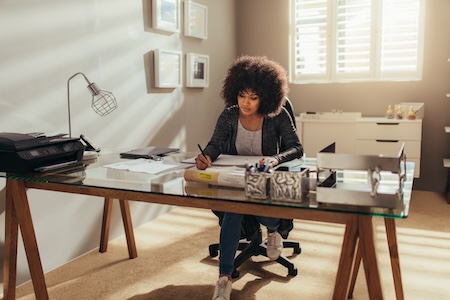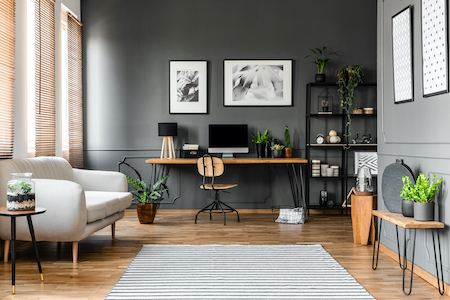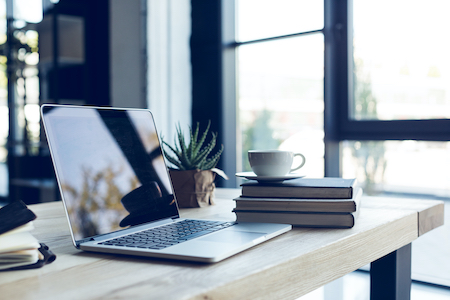Revamping Your Home Office Space with Stylish and Durable Flooring
What does your home office space look like? Do you hang out in the kitchen? Pull up a chair at the dining room table?
Work-from-home numbers were low before 2020; that all changed when people stayed home. According to a recent Pew Research Center poll, around 22 million employed adults in the US work from home all the time. That’s roughly 14 percent. By 2025, Upwork predicts that number will increase to 22 percent.
If you’re working from home full-time, maybe it’s time to break away from the kitchen island and create a place that works for you instead. Maybe an extra bedroom. Or maybe a redesign that gives you the space you desire.
No matter where your new home office space goes, the best place to start is with the flooring.
Flooring – The Best Place To Start With Any New Design
When you’re starting any new remodel or design, it’s easy to start with what you love. Cabinets in the kitchen. Showerheads in the bath.
For new home office space, it might be the gorgeous desk you’ve had your eye on. Or shelves to place all of your books.
Before you get to the details, we suggest you look down at your floors instead.
Flooring sets the tone for the entire room. It provides a base color and texture palette from which you can build the rest of your design.
 Starting with the floor ensures that the overall look of the room remains cohesive, as other elements like furniture, wall colors, and accessories will be chosen to complement the flooring.
Starting with the floor ensures that the overall look of the room remains cohesive, as other elements like furniture, wall colors, and accessories will be chosen to complement the flooring.
It also sets the foundation for function. The type of flooring chosen directly impacts the room’s functionality. For a home office, considerations like durability, ease of maintenance, and comfort are crucial, as the space needs to withstand daily use. The right flooring can enhance comfort, which is particularly important in a workspace where you spend long hours. Options like carpet or cushioned vinyl can reduce fatigue and make standing or moving around more comfortable.
Or maybe you’ll be recording podcasts, or hosting regular video calls. Flooring can significantly affect the acoustics of a room. Carpet or engineered wood can help absorb sound, reducing noise levels and creating a quieter, more conducive work environment.
Then there’s the consideration of practicality. Flooring should typically be installed first to avoid damaging newly painted walls or furniture. It’s easier to lay flooring without obstacles and ensures a clean, professional finish. Installing flooring can be a disruptive process, often involving moving furniture and potentially creating dust or debris. Completing this step first minimizes the impact on other finished elements of the room.
Creating a Flooring Plan – A Step-By-Step Guide
Start searching for flooring and you can quickly move into overwhelm. There are so many choices! Yet if you dig deep, you probably have a few ideas in mind.
Don’t fall in love from the start. Instead, assess your needs. Consider the amount of foot traffic the office will see. Higher traffic areas need more durable flooring. Think about comfort underfoot, especially if you’ll be standing a lot or using a chair with wheels. Decide on the style and look you want to achieve, ensuring it complements the rest of your home decor.
This is about looking at your day-to-day life. Build a home office that’s functional and can offer you what you need most.
This will help lead you to what flooring materials to choose.
- Hardwood: Classic and durable, hardwood is long-lasting and adds value to your home. It’s ideal for a professional look.
- Laminate: A cost-effective alternative to hardwood, laminate is durable and comes in various styles that mimic natural wood or stone.
- Vinyl Plank: Highly durable and water-resistant, vinyl plank flooring is ideal if you want the look of wood or stone without the maintenance.
- Carpet Tiles: Good for sound absorption and comfort, carpet tiles can be easily replaced if damaged.
- Engineered Wood: Combines a real wood veneer with a plywood core, offering the look of hardwood with added stability.
As you look through this list, does something move to the top of the list? Do several have appeal? This is when it pays to start searching. Use Pinterest or do a search. Look at home offices and see what you like. This can be your best guide to finalizing your decision.
From here, you can continue narrowing down your selection by thinking about how you’ll use your office.
Choose materials that are easy to clean and maintain. Consider scratch-resistant options if you have office chairs with wheels.
Flooring like carpet or luxury vinyl can help reduce noise, which is beneficial if you need a quiet workspace or have frequent virtual meetings.
Determine your budget and find a balance between quality and cost. Remember, investing in higher-quality flooring can pay off in the long run with durability and maintenance savings.
Then once you have your ideas in mind, it’s time to consult with a flooring expert to get professional advice tailored to your specific needs and preferences. We also suggest to ensure proper installation that you hire experienced professionals to avoid issues like uneven surfaces or improper fitting.
As you visit our store, take home samples of different flooring options to test them out in your space. Live with them for a few days to see them in different lighting conditions and see how they feel underfoot. You may not have your office furniture in place, but you can see what feels right every time you walk into the space.
One will call out to you. One will say, “pick me.”
That’s how you know you’ve found the right flooring for your home office space. That’s when you can say “yes” to the right flooring.
No matter where you are in your planning, we feel the best place to start is at the foundational level. Build your space to work for your business dreams. Install quality flooring to establish the aesthetics.
We’re here to help you along the way.

 That’s a question we frequently see these days. The short answer is: Yes!
That’s a question we frequently see these days. The short answer is: Yes! And at the base is your home office flooring. Here are a few things to consider.
And at the base is your home office flooring. Here are a few things to consider. Hardwood
Hardwood